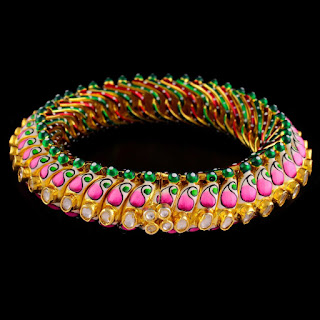silver bangles
Bangles are traditionally rigid bracelets, originating from the Indian subcontinent, which are usually made of metal, wood, glass or plastic. They are traditional ornaments worn mostly by women from the Indian subcontinent. It is common to see a new bride wearing glass bangles at her wedding, the traditional view is that the honeymoon will end when the last bangle breaks. Bangles also have a very traditional value in Hinduism and it is considered inauspicious to be bare armed for a married woman. Bangles may also be worn by young girls and bangles made of gold or silver are preferred for toddlers.
Bangles are circular in shape, and, unlike bracelets, are not flexible. The word is derived from Hindi bungri (glass). They are made of numerous precious as well as non-precious materials such as gold, silver, platinum, glass, wood, ferrous metals, plastic, etc. Bangles made from sea shell, which are white colour, are worn by married Bengali and Oriya Hindu women. A special type of bangle is worn by women and girls, especially in the Bengal area, commonly known as a "Bengali bangle", which is used as a substitute for a costly gold bangle, and is produced by fixing a thin gold strip (weighing between 1–3 g) is thermo-mechanically fused onto a bronze bangle, followed by manual crafting on that fused gold strip.
Bangles are part of traditional Indian jewellery. They are usually worn in pairs by women, one or more on each arm. Most Indian women prefer wearing either gold or glass bangles or a combination of both. Inexpensive bangles made from plastic are slowly replacing those made by glass, but the ones made of glass are still preferred at traditional occasions such as marriages and on festivals. Bangles are the signs for traditional women and girls. Bangles play a very important role in various India dance forms. Some of dance forms include bangles striking to each other a tone of the music.
The designs range from simple to intricate handmade designs, often studded with precious and semi-precious stones such as diamonds, gems and pearls. Sets of expensive bangles made of gold and silver make a jingling sound. The imitation jewellery tends to make a tinny sound when jingled.
Bangles are circular in shape, and, unlike bracelets, are not flexible. The word is derived from Hindi bungri (glass). They are made of numerous precious as well as non-precious materials such as gold, silver, platinum, glass, wood, ferrous metals, plastic, etc. Bangles made from sea shell, which are white colour, are worn by married Bengali and Oriya Hindu women. A special type of bangle is worn by women and girls, especially in the Bengal area, commonly known as a "Bengali bangle", which is used as a substitute for a costly gold bangle, and is produced by fixing a thin gold strip (weighing between 1–3 g) is thermo-mechanically fused onto a bronze bangle, followed by manual crafting on that fused gold strip.
Bangles are part of traditional Indian jewellery. They are usually worn in pairs by women, one or more on each arm. Most Indian women prefer wearing either gold or glass bangles or a combination of both. Inexpensive bangles made from plastic are slowly replacing those made by glass, but the ones made of glass are still preferred at traditional occasions such as marriages and on festivals. Bangles are the signs for traditional women and girls. Bangles play a very important role in various India dance forms. Some of dance forms include bangles striking to each other a tone of the music.
The designs range from simple to intricate handmade designs, often studded with precious and semi-precious stones such as diamonds, gems and pearls. Sets of expensive bangles made of gold and silver make a jingling sound. The imitation jewellery tends to make a tinny sound when jingled.

Comments
Post a Comment